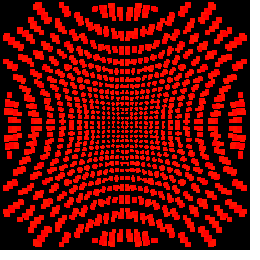
|
Rio-Imager
|
 |

|
Rio-Imager
|
 |

A new riometer imager experiment with a spatial resolution, exceeding that of current systems by an order of magnitude, is under construction in Northern Scandinavia near Tromso. With the Rio-Imager we obtain simultaneous measurements of ionospheric absorption over a large field of view (90 000 km^2) with good spatial and temporal resolution. Observations of the spatial variations of absorption and the dynamics will allow a detail in the analysis of particle precipitation, which can not at present be obtained with any other technique.
| Science objectives |
|
| Related links |
|
| Publications by MPS members |
![[Antenna Image]](/images/projekte/rio-imager/antenna.gif)
Riometers using antennas with narrow antenna beams have been widely used to study acceleration, propagation, and precipitation of energetic charged particles into the Earth's ionosphere.
A new riometer imager experiment with a spatial resolution, exceeding that of current systems by an order of magnitude, is under construction in Northern Scandinavia near Tromso. This site in the auroral zone is chosen because it allows joint observations with many other experiments: STARE (=Scandinavian Twin Auroral Radar Experiment) measures horizontal electron flows in the ionospheric E region over a large area (400*400 km) with good spatial resolution (20*20 km); EISCAT provides detailed plasma physical parameters in an area over Tromso (for example vertical variations of electron density and electron collision frequency). Also optical measurements (DASI), neutral wind observations, and HF radar experiments are available over northern Scandinavia. Rockets launched from Andoya - and Kiruna Rocket Ranges have trajectories passing inside the field of view of the riometer imager. Several spacecraft missions will provide further opportunities for joint research: POLAR, WIND, INTERBALL, GEOTAIL, CLUSTER, SOHO.
The new riometer imager experiment is based on the principles of a Mill's Cros. The antenna array consist of two perpendicular rows of antennas, each row containing 32 antenna. Each row is connected to an 32-element Butler Matrix. In this way 32 dish-like fan shaped antenna lobes are formed located symmetrically around zenith and with the fans perpendicular to the vertical plane containing the row of antennas. The fans associated with the two rows are therefore perpendicular to each other. The signal is received in each of the outputs from the two Butler Matrices. Considering a fan from each Butler Matrix (fan-"i" and fan-"j"), the common solid angle of these define a direction, a narrow beam, and the received signals have in common the signal from this direction. Cross correlating the signals from the two dish-like beams yield a measure, the cross-correlation (Iij), of the signal intensity in the common direction. In this way directional intensities can be obtained in a number of direction that equals the square of the number of antennas in one arm of the Mill's Cross (322 = 1024). The area of intersection of each antenna beam with the ionosphere is shown in Figure 2 to illustrate the spatial resolution and coverage of the Rio-Imager experiment.
Coordinates : 69.7N, 19.23E Frequency : 38.2 MHz Number of antennas : 64 Half power beam width : 3.6 degrees Resolution in 90 km altitude : 6 km Field of view : 300x300 km Time resolution : 1 s
The Rio-Imager experiment is a joint project between Germany and United Kingdom.
![]() Max-Planck-Institut für
Sonnensystemforschung
(MPS), Dr. E. Nielsen,
Germany
Max-Planck-Institut für
Sonnensystemforschung
(MPS), Dr. E. Nielsen,
Germany
![]() Lancaster University, Department of Communication
, Dr. F. Honary, UK
Lancaster University, Department of Communication
, Dr. F. Honary, UK
| © 2006, Max-Planck-Institut für Sonnensystemforschung, Lindau |
Nielsen 21-11-2001 |